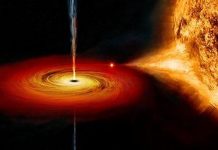
Oct. 28 (UPI) — Astronomers are tracking what they believe may be the first observed interstellar asteroid or comet to travel through Earth’s solar system, NASA said.
The space agency said the object is less than a quarter mile in diameter and is traveling “remarkably fast.” They’re not sure what exactly it is.
Paul Chodas, manager of NASA’s Center for Near-Earth Object Studies, said the agency has been “waiting for this day for decades.”
“It’s long been theorized that such objects exist — asteroids or comets moving around between the stars and occasionally passing through our solar system — but this is the first such detection. So far, everything indicates this is likely an interstellar object, but more data would help to confirm it,” he added.
The University of Hawaii’s Pan-STARRS 1 telescope discovered the object, named A/2017 U1, on Oct. 19. Post-doctoral researcher Rob Weryk first spotted the object.
“Its motion could not be explained using either a normal solar system asteroid or comet orbit,” he said.
Weryk said he also reviewed images taken at the European Space Agency’s telescope in the Canary Islands and determined: “This object came from outside our solar system.”
NASA scientist Davide Farnocchia said the object has the most extreme orbit he’s ever seen.
“It is going extremely fast and on such a trajectory that we can say with confidence that this object is on its way out of the solar system and not coming back,” he said.
NASA’s Center for Near-Earth Object Studies determined the object came from the direction of the Lyra constellation and is traveling about 15.8 miles per second.
A/2017 U1 approached the solar system from above the ecliptic — the plane on which the planets and most asteroids orbit the sun. Pulled in by the sun’s gravity, the object then made a “hairpin” turn underneath the ecliptic, passing about 15 million miles under Earth. It began traveling back above the plane and is making its way toward the Pegasus constellation.
“We have long suspected that these objects should exist, because during the process of planet formation a lot of material should be ejected from planetary systems. What’s most surprising is that we’ve never seen interstellar objects pass through before,” said Karen Meech, an astronomer at the Institute for Astronomy.
Since it’s potentially the first object of its kind, the International Astronomical Union must first determine a naming convention before A/2017 U1 can get a permanent name.






